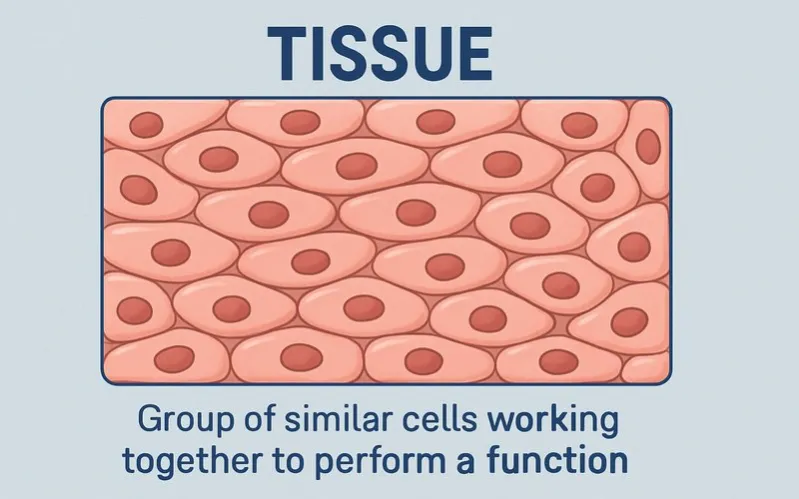The Amazing World of Tissues
The Four Primary Types of Animal Tissues
Just as a sports team has players with different positions and skills, your body is made up of teams of cells called tissues. Scientists group animal tissues into four main categories, each with a unique job description.
| Tissue Type | Main Function | Key Locations | Cell Examples |
|---|---|---|---|
| Epithelial | Covering, protection, secretion, absorption | Skin, lining of digestive tract, lungs | Squamous, cuboidal, columnar |
| Connective | Support, binding, cushioning, transport | Bones, blood, fat, tendons | Osteocytes (bone), erythrocytes (red blood cells) |
| Muscle | Movement (body and internal organs) | Heart, skeletal muscles, stomach | Skeletal, cardiac, smooth muscle cells |
| Nervous | Communication, control, coordination | Brain, spinal cord, nerves | Neurons, glial cells |
A Closer Look at Connective Tissue Diversity
Connective tissue is the most abundant and diverse tissue type. It's the body's packing material, support system, and delivery service all rolled into one. Its cells are usually spread out within an extracellular matrix1, a non-living material that can be liquid, gel-like, or solid.
| Type | Matrix Composition | Function | Example |
|---|---|---|---|
| Loose Connective | Gel-like matrix with collagen & elastic fibers | Binds skin to underlying muscles, provides support | The layer under your skin (dermis) |
| Fibrous (Dense) Connective | Dense parallel bundles of collagen fibers | Provides strong attachment and tension resistance | Tendons (muscle to bone), ligaments (bone to bone) |
| Bone | Solid matrix of calcium salts and collagen | Support, protection, movement, mineral storage | Femur, skull, vertebrae |
| Cartilage | Firm, flexible matrix of collagen | Support, cushioning, reduces friction | Nose tip, external ear, between vertebrae |
| Adipose | Minimal matrix; cells filled with lipid droplet | Energy storage, insulation, cushioning | Fat layer under the skin, around organs |
| Blood | Liquid matrix called plasma | Transport of gases, nutrients, wastes; immunity | Flowing through arteries, veins, and capillaries |
From Cells to Systems: The Hierarchy of Life
Tissues are a crucial middle step in the organization of life. They form the bridge between individual cells and the complex systems that keep an organism alive. The hierarchy can be visualized as:
$Cell \rightarrow Tissue \rightarrow Organ \rightarrow Organ System \rightarrow Organism$
An organ is a structure made up of two or more different types of tissues that work together for a common purpose. For example, your stomach is an organ. Its inner lining is made of epithelial tissue that secretes digestive juices. It contains smooth muscle tissue that churns the food. It is wrapped in connective tissue that holds it together and connects it to other organs, and it is infused with nervous tissue that controls its actions.
The Inner Workings of a Tissue in Action
Let's follow the journey of a single oxygen molecule you just inhaled to see how multiple tissues collaborate. The oxygen enters the lungs, which are organs made primarily of epithelial tissue (for gas exchange) and elastic connective tissue (to allow expansion).
The oxygen diffuses across the thin epithelial tissue lining the air sacs (alveoli) and into a capillary. This capillary is a tiny blood vessel whose wall is also made of a single layer of epithelial cells. Now the oxygen is in the blood, a fluid connective tissue. It binds to a red blood cell (erythrocyte).
The heart, an organ made of cardiac muscle tissue, connective tissue, and nervous tissue, pumps this oxygen-rich blood through arteries. The blood travels to your leg, where you are running. The muscle tissue in your leg is working hard and needs oxygen. The oxygen diffuses out of the capillary and into the muscle cell. Inside the muscle cell, the oxygen is used in a chemical reaction to produce energy ($C_6H_{12}O_6 + 6O_2 \rightarrow 6CO_2 + 6H_2O + Energy$). The waste product, carbon dioxide ($CO_2$), then makes the reverse journey back to your lungs to be exhaled. This entire process requires the seamless, coordinated effort of epithelial, connective, and muscle tissues.
Common Mistakes and Important Questions
A: No, plants have tissues too! While they are different from animal tissues, they are also groups of similar cells working together. Major plant tissue types include dermal tissue (the plant's "skin"), ground tissue (for storage and support), and vascular tissue (the plant's "plumbing system" made of xylem and phloem to transport water and food).
A: Yes, blood is classified as a connective tissue. Remember, the definition of a tissue is a group of similar cells working together. Blood contains similar cells like red blood cells, white blood cells, and platelets. These cells are suspended in a liquid extracellular matrix called plasma, which makes it different in appearance from solid tissues like bone or muscle, but it still fits the definition perfectly.
A: This is a common point of confusion. A tissue is made of only one type of cell (e.g., muscle cells form muscle tissue). An organ is a structure made of several different tissues integrated together. For example, the heart (an organ) contains muscle tissue, connective tissue, epithelial tissue lining its chambers, and nervous tissue.
Footnote
1 Extracellular Matrix (ECM): A complex network of non-living materials (like proteins and sugars) secreted by cells that provides structural and biochemical support to the surrounding cells. It is a major feature of connective tissues.

